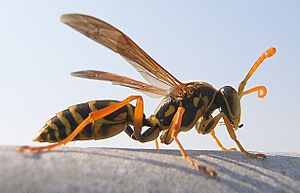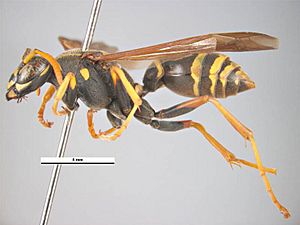Polistes chinensis facts for kids
Quick facts for kids Polistes chinensis |
|
|---|---|
 |
|
| Polistes chinensis antennalis | |
| Scientific classification | |
| Synonyms | |
|
The Polistes chinensis is a type of wasp often called the Asian, Chinese, or Japanese paper wasp. It lives in East Asia, especially in China and Japan. One kind of this wasp, P. chinensis antennalis, became an invasive species in New Zealand in 1979. This means it spread to a new place and caused problems for local plants and animals.
These wasps hunt small invertebrates, like caterpillars, for food. In their colonies, the queen wasp often destroys eggs laid by other worker wasps. Worker wasps also help the queen do this, a behavior called worker policing.
Contents
About the Asian Paper Wasp
The Asian paper wasp belongs to a large group of wasps called Polistes. This group has over 300 different types of wasps. Scientists have found two main kinds of the Asian paper wasp:
- P. chinensis chinensis
- P. chinensis antennalis
What Does the Asian Paper Wasp Look Like?
The Asian paper wasp has a thin body. It is usually about 13 to 25 millimeters (0.5 to 1 inch) long. Their bodies can be reddish-brown or black. They often have yellow rings and reddish spots on their belly area.
Their wings are a reddish or amber-brown color. They also have long legs that hang down when they fly.
Where Do Asian Paper Wasps Live?
Asian paper wasps often build their nests on human-made structures. These can include houses and other buildings. They also build nests on trees or bushes, usually on branches or even leaves.
These wasps like to live in cities and towns. However, their nests have also been found near forest clearings. Sometimes, they hide their nests in thick bushes, making them hard to find. Large groups of these wasps are common in warm, low-lying areas. They prefer open spaces like shrublands, swamps, and meadows.
Where Are They Found?
The Asian paper wasp is originally from East Asia. It has been seen in China, Japan, Korea, and Mongolia. The P. chinensis antennalis type is an invasive species in New Zealand. It has spread across the North Island and the northern part of the South Island. These wasps compete with local species for food.
They have also been found in Norfolk Island and New South Wales, Australia. Scientists believe the wasps in New Zealand came from two different areas in Japan. The Asian paper wasp was first seen in New Zealand in 1979. It was in Kohimarama and the Whangaparaoa Peninsula. For a few years, they stayed in these areas of Auckland. But by 1984, they started appearing in other parts of the city.
Life Cycle of a Paper Wasp Colony
The life of an Asian paper wasp colony starts in the spring. A female wasp, called the foundress, wakes up after winter. She was fertilized in the fall. She then starts building the nest and laying eggs.
The first baby wasps hatch in late spring or early summer. These first wasps are all females. Later in the summer, male wasps start to appear. After males are produced, no more female wasps are born for the rest of the year.
This colony life cycle has three main parts:
- Solitary Stage: The foundress builds the nest alone and cares for the first group of young. This stage ends when the first worker wasps appear.
- Superindividual Stage: This stage lasts until the first wasps that can reproduce (queens and males) emerge.
- Social Stage: This final stage continues until the colony breaks apart.
How Wasps Use Resources
Finding food is very hard work for the foundress. It is also risky because she could die while looking for food. But it is important for the colony to survive. Most of the protein food she collects goes to feeding the young wasps (larvae).
Wasps also use a special liquid from their mouths to glue nest materials together. This helps them build and fix the nest. This liquid is mostly made of protein. The queen will make more of this liquid if needed. For example, during rainy seasons, the foundress uses more of this liquid to protect the nest from getting wet and falling apart.
Survival Strategies: Cannibalism
When a foundress is alone, finding food is risky for her and her young. Also, it can be hard for her to find enough food. If there isn't enough honey or prey, P. chinensis wasps might eat their own young. This happens during the solitary stage of the colony.
The foundress chooses which young to eat based on what food is missing. If there isn't enough prey, she eats younger larvae. She then feeds these to older larvae. This helps the older larvae grow into the first worker wasps. It is very important for the queen to raise these first workers successfully. This is because she is at high risk of dying while caring for the nest alone.
If there isn't enough honey, older larvae are more likely to be eaten. When older larvae don't get enough honey, they stop making saliva. This saliva is an important nutrient for adult wasps. If large larvae can't make enough saliva, they might be eaten by the foundress herself for nutrients.
Protecting the Nest
Foundresses must leave the nest to find food, building materials, and water. When they are away, other female wasps might try to steal their young. These attacking wasps fly to a nest, grab a larva, and take it back to their own nest to feed their own young.
Foundresses chase away attacking wasps by flying in a spiral pattern. This is when two wasps fly in a double helix shape in the air. Being present at the nest helps keep attackers away. Foundresses notice when a larva is taken. This makes them work harder to defend the nest. If a larva is removed, a lone foundress spends more time on the nest. She spends less time on activities away from the nest. She also waits longer between leaving the nest. After about 30 minutes, the time she spends on the nest starts to go back to normal. After 60 minutes, it is back to how it was before.
Wasp Family Dynamics
Asian paper wasps have a unique way of organizing their families. In these colonies, male wasps are born from eggs that have not been fertilized.
Conflict Over Reproduction
Worker wasps often destroy each other's eggs. About 88.5% of the queen's eggs survive to hatch. But only about 1.4% of worker-laid eggs survive. Even when the queen is alive, workers often lay eggs. Both the queen and other workers will remove worker-laid eggs.
Scientists have studied P. chinensis alongside another wasp, Polistes snelleni, to compare. In P. snelleni, the queen lays almost all the eggs. In P. chinensis, workers lay many eggs. In a colony with 100 to 500 wasps, workers might lay three or four times more eggs than the queen.
Why Workers Police Each Other
Worker-on-worker policing is expected in nests where the queen has mated with many males. But P. chinensis queens usually mate with only one male. So, why do workers police each other?
One idea is that worker policing helps the colony work better. Laying eggs might make workers less productive at other tasks. However, workers only destroy eggs when they are also laying their own. This suggests that non-reproductive workers might not police others.
Another idea is that policing happens because of limited space in the nest. As the colony grows, workers lay more eggs than the queen. This means there is less space for new eggs. Workers might destroy other workers' eggs to make room for their own. This idea still needs more study to be fully confirmed.
What Do Asian Paper Wasps Eat?
P. chinensis wasps drink nectar from flowers and honeydew. They hunt small invertebrates for protein. They especially like larvae and caterpillars of moths and butterflies. Sometimes, they will also eat marine invertebrates or dead fish if they find them.
Asian paper wasps also eat the larvae of other female wasps from their own species. The saliva from wasp larvae is an important nutrient for adult Asian paper wasps. This saliva has a lot of amino acids, much more than flower nectar. It is like a super-nutritious drink for the adult wasps.


